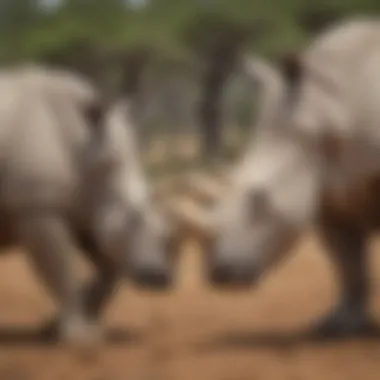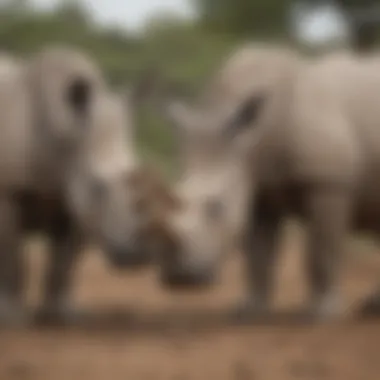In-Depth Analysis on the 2021 Status of Northern White Rhinos


Animal Species Profile
- Introduction to the animal species
The northern white rhinoceros, native to the grassy plains of central Africa, is one of the most iconic and majestic members of the rhinoceros family. Known for their thick, square-shaped lips and two horns on the snout, they are characterized by their powerful build and distinct gray skin. These gentle giants are herbivores, primarily grazing on grasses and browsing on shrubs in their natural habitat.
- Physical characteristics and appearance
Northern white rhinos are known for their massive size, with males weighing up to 2,300 kg (5,000 lbs) and standing over 6 feet tall. Their two horns, made of keratin, can reach lengths of up to 1.5 meters (5 feet). These rhinos have a broad square lip adapted for feeding on vegetation and a hump on the back of their neck, giving them a unique appearance among rhinoceros species.
- Natural habitat and distribution
Historically, northern white rhinos roamed across Uganda, Chad, Sudan, the Central African Republic, and the Democratic Republic of the Congo. However, due to rampant poaching and habitat loss, their population has significantly dwindled. Currently, the only two remaining northern white rhinos, both female, are under protection in a sanctuary in Kenya, highlighting the critical status of this subspecies.
- Behavior and social interactions
Despite their massive size, northern white rhinos are generally docile and social animals. They are often found congregating in small groups known as crashes. These crash groups are led by a dominant female and communicate through various vocalizations, body postures, and scent marking. The social structure of northern white rhinos plays a crucial role in their survival and well-being, emphasizing the importance of conservation efforts to protect their remaining populations.
Understanding Northern White Rhinos
Understanding Northern White Rhinos holds a paramount significance within the context of this article, as it serves as the foundation for comprehending the intricate dynamics involved in the conservation and preservation of this endangered species. By delving into the intricate details of Northern White Rhinos, readers can grasp the complexities of their habitat, behaviors, and the challenges they face in the present day. This section acts as a gateway into the broader discussion on the status and future prospects of Northern White Rhinos in 2021.
Background Information
Origin and Distribution
Unveiling the roots of Northern White Rhinos, their origin and distribution shed light on their historical evolution and geographical spread. Examining this specific aspect is crucial in understanding how these magnificent creatures adapted to their environment over time. The distinctiveness of their origin and distribution not only enriches our knowledge of their journey but also underscores the importance of preserving their genetic diversity. Despite the challenges they have encountered in the wild, their resilience in varying habitats is a testament to their survival instincts, making them a relevant subject for this article.


Physical Characteristics
Exploring the physical attributes of Northern White Rhinos reveals essential details about their adaptation and survival mechanisms. The unique features of their physical characteristics, such as their thick skin and distinctive horns, contribute significantly to their identity and role within their ecosystem. Understanding these traits enhances our appreciation for their biological makeup and highlights the challenges they face due to their distinctive features. While their physical characteristics provide them with advantages in certain situations, they also make them vulnerable to threats, underscoring the delicate balance they maintain in their natural environment.
Population Overview
Historical Numbers
Tracing the historical numbers of Northern White Rhinos unveils a story of decline and resilience throughout the years. Analyzing this specific aspect allows us to contextualize their current population status and extinction risks. The dwindling historical numbers emphasize the impact of human activities on their population dynamics, underscoring the urgent need for conservation efforts. Despite facing immense challenges in the past, the historical numbers of Northern White Rhinos serve as a reminder of their endurance and the critical importance of preserving their species.
Current Population Status
Evaluating the current population status of Northern White Rhinos offers insights into the existing challenges and opportunities for their conservation. The data surrounding their current population status enables conservationists to strategize and implement effective measures to reverse the downward trend. The current population status not only reflects the concerted efforts of conservation initiatives but also underscores the fragility of their existence in the face of multiple threats. By examining their current numbers, we gain a clearer perspective on the urgency of conservation actions and the necessity of safeguarding their habitat.
Behavioral Traits
Social Structure
The social structure of Northern White Rhinos unveils intricate dynamics of communal living and social hierarchies within their groups. Understanding this specific aspect illuminates the cooperation and conflict resolution mechanisms employed by these majestic animals. The significance of their social structure lies in the preservation of family units and the transfer of knowledge from one generation to the next. While their social behavior offers advantages in terms of group protection, it also exposes them to vulnerabilities during environmental disruptions, emphasizing the complex interplay between their behavior and survival strategies.
Feeding Habits
Exploring the feeding habits of Northern White Rhinos provides critical insights into their diet preferences and foraging behaviors. Their feeding habits play a vital role in shaping their ecosystem and influencing plant diversity in their habitats. By studying this specific aspect, we gain a deeper understanding of their nutritional requirements and the challenges they face due to habitat degradation and competition for resources. While their feeding habits showcase their adaptive capabilities, they also highlight the interconnectedness between their diet, habitat, and overall well-being, emphasizing the importance of conservation efforts in sustaining their feeding ecosystems.
Historical Challenges and Extinction Threat
The aspect of Historical Challenges and Extinction Threat within the comprehensive exploration of the status of Northern White Rhinos in 2021 holds paramount significance. It serves as a critical focal point that delves deep into the various factors that have led to the decline of this majestic species. By shedding light on the historical challenges faced by Northern White Rhinos and the imminent threat of extinction they currently confront, readers gain a profound understanding of the urgency associated with conserving these animals. The section meticulously examines the impacts of detrimental human activities such as poaching and habitat loss on the population decline of Northern White Rhinos.
Factors Leading to Decline
Poaching
The factor of poaching presents a harrowing reality in the narrative of the Northern White Rhinos' decline. Poaching, characterized by the unlawful hunting of these rhinos for their horns, stands as a poignant menace to their survival. The ruthless pursuit of these magnificent creatures for the illegal wildlife trade underscores the brutal lengths to which poachers will go to profit from their horns, which hold perceived medicinal value in some cultures. This barbaric practice not only decimates the rhino population but also disrupts the delicate ecosystem these animals are integral to. Despite global conservation efforts, the persistent threat of poaching continues to cast a dark shadow on the future of Northern White Rhinos.
Habitat Loss
The issue of habitat loss emerges as another crucial factor contributing to the decline of Northern White Rhinos. The rampant destruction of their natural habitats due to expansion of human settlements, agriculture, and other anthropogenic activities poses a severe threat to the survival of these rhinos. Habitat loss not only diminishes the available space for Northern White Rhinos to roam freely but also disrupts their feeding and breeding patterns. The rapid encroachment into their habitats exacerbates the vulnerability of these endangered animals, pushing them further towards the brink of extinction. Addressing the root causes of habitat loss and implementing sustainable conservation practices are imperative to safeguard the future of Northern White Rhinos.
Extinction Risk Assessment
Current Threats
Examining the current threats faced by Northern White Rhinos unveils a worrisome landscape permeated by various challenges. Illegal wildlife trafficking, habitat fragmentation, and human-wildlife conflicts are among the predominant threats that threaten the survival of these iconic creatures. The insidious activities of poachers, coupled with the unsustainable exploitation of their habitats, pose immediate dangers to the dwindling population of Northern White Rhinos. It is imperative to combat these threats through robust conservation strategies and international collaborations to secure a sustainable future for these rhinos.
Predictions for the Future
Forecasting the future of Northern White Rhinos involves a complex interplay of multiple factors that dictate their survival prospects. Projections suggest that without decisive intervention and concerted conservation efforts, the fate of these rhinos hangs precariously in the balance. Anticipated scenarios paint a sobering picture of the challenges ahead, emphasizing the critical need for unwavering commitment towards species preservation. By juxtaposing the current trajectory with potential future outcomes, conservationists and stakeholders can chart a course that offers hope for the enduring existence of Northern White Rhinos.
Conservation Efforts and Initiatives
Conservation Efforts and Initiatives play a vital role in the ongoing battle to save the critically endangered Northern White Rhinos. As extinction looms, these efforts are crucial in securing the future of this majestic species. Conservation initiatives encompass a wide array of strategies aimed at protecting the remaining population, restoring habitats, and raising awareness about the plight of the species. These efforts not only focus on preserving the Northern White Rhinos but also contribute to the broader conservation of biodiversity. With the collaboration of various organizations, governments, and wildlife experts, Conservation Efforts and Initiatives serve as the beacon of hope for the survival of these magnificent creatures. By highlighting their significance in this article, readers will gain a holistic understanding of the multifaceted approach needed to ensure the existence of the Northern White Rhinos. ### n Situ Conservation Programs ### ### Pro Reserves #### Within the of In Situ Conservation Programs, Protected Reserves stand out as sanctuaries designated specifically for the preservation of wildlife. These areas serve as safe havens for endangered species like the Northern White Rhinos, offering protection from poaching and habitat loss. The key characteristic of Protected Reserves lies in their ability to mimic natural environments, providing a suitable habitat for the species to thrive. While these reserves are essential for safeguarding biodiversity, they also face challenges such as encroachment and resource scarcity. Despite these obstacles, Protected Reserves remain a cornerstone in the conservation efforts for Northern White Rhinos. #### Breeding Prog
In the landscape of c
ation, Breeding Programs emerge as vital components in the fight against species extinction. These programs aim to increase the population of endangered species through controlled breeding in captive settings. The key characteristic of Breeding Programs lies in their ability to manage genetic diversity and ensure the survival of the species through captive breeding initiatives. While these programs offer hope for species recovery, they also raise ethical dilemmas regarding the wild versus captive debate. Despite these ethical concerns, Breeding Programs stand as indispensable tools in the conservation toolbox for Northern White Rhinos. ### Advancements in Assisted oductive Technologies ### #### IVF Techniques #### Adv ent ssisted Reproductive T ogies, such as In Vitro Fertilization (:@


The Future of Northern White Rhinos
For this crucial section, it is essential to dwell upon the future prospects of the Northern White Rhinos as they stand at the brink of extinction in 2021. Understanding the challenges and opportunities that lay ahead for this magnificent species is paramount in shaping conservation efforts and safeguarding their existence. By delving deeper into the potential outcomes and implications of various conservation strategies, we can gain invaluable insights into the path that lies ahead for these endangered creatures.
Prospects for Population Recovery
Challenges Ahead
The meticulous examination of the 'Challenges Ahead' in reviving the Northern White Rhino population sheds light on the intricate hurdles that conservationists face in their mission. Addressing factors like habitat preservation, genetic diversity, and anti-poaching measures is vital to ensure a sustainable recovery strategy. Discussing the specific challenges in detail offers a comprehensive view of the complexities involved and underscores the urgency of proactive conservation measures to counteract the decline.
Optimistic Scenarios
Exploring optimistic scenarios provides a glimpse into a hopeful future where Northern White Rhinos thrive once again. These scenarios could encompass successful breeding programs, enhanced protection measures, and international collaboration for conservation. By envisioning positive outcomes, we can inspire concerted efforts towards species recovery, highlighting the potential for a brighter tomorrow for the Northern White Rhinos.
Ethical and Moral Debates
Cloning Controversies
The discourse on 'Cloning Controversies' delves into the ethical considerations surrounding the use of advanced reproductive technologies in species conservation. Evaluating the implications of cloning on genetic diversity and ecosystem integrity is paramount in ethical decision-making. By dissecting the complexities of this contentious issue, we can better understand the ethical nuances involved in preserving endangered species.
Wild vs. Captive Dilemma
The 'Wild vs. Captive Dilemma' presents a moral quandary in the conservation of Northern White Rhinos, weighing the benefits of ex-situ and in-situ conservation approaches. Scrutinizing the advantages and drawbacks of each method offers valuable insights into the most ethical and effective strategies for species preservation. By evaluating the implications of wild vs. captive environments, we can navigate the ethical dilemmas inherent in conservation efforts.
Education and Awareness Campaigns
Community Outreach
The significance of 'Community Outreach' in fostering conservation awareness and eliciting public support for the Northern White Rhinos cannot be overstated. Leveraging community engagement to promote environmental education and advocacy fosters a culture of conservation stewardship. Delving into effective outreach strategies illuminates the impact of grassroots initiatives in shaping attitudes towards wildlife conservation.
Public Engagement Strategies
The exploration of 'Public Engagement Strategies' underscores the importance of inclusive and impactful initiatives to raise awareness about the plight of the Northern White Rhinos. Crafting engaging and informative campaigns tailored to various audiences amplifies conservation messaging and mobilizes public support. By scrutinizing the effectiveness of diverse engagement approaches, we elucidate the pivotal role of public advocacy in safeguarding endangered species.







